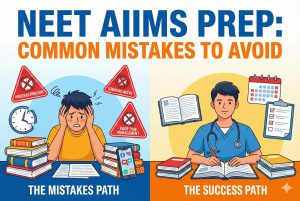Introduction
Every JEE aspirant knows that taking mock tests is essential — but mock tests only help when you analyse them correctly. Many students focus on the score alone and ignore the most valuable part — understanding their mistakes. That’s where JEE Mock Test Analysis comes in.
Analysing mock tests is not just about knowing what went wrong; it’s about identifying why it went wrong and how to fix it before the real exam. In this blog, we’ll explain step-by-step how to analyse your JEE mock test results to boost accuracy, speed, and confidence.
1. Why JEE Mock Test Analysis Is So Important
Most students treat mock tests as performance checks, but they’re actually learning tools. Each mock reveals your:
-
Conceptual weaknesses
-
Time management habits
-
Accuracy under pressure
-
Question selection strategy
Without proper analysis, you’ll keep repeating the same mistakes. A good JEE mock test analysis helps you:
✅ Identify weak chapters and topics
✅ Understand recurring errors
✅ Refine your problem-solving speed
✅ Plan better revision strategies
In short, mock tests show what you know, but analysis tells you what to fix.
2. Step-by-Step Guide to JEE Mock Test Analysis
Here’s a simple, effective way to analyse each JEE mock test:
Step 1: Record Your Raw Data
After every test, note down:
-
Total attempted questions
-
Correct and incorrect answers
-
Time spent per section (Physics, Chemistry, Math)
-
Overall score and percentile
Keep this in a spreadsheet or notebook so you can track progress after every test.
Step 2: Classify Each Question
Go through all 90 questions (or however many were in your mock). For each question, mark it as:
-
Correct & Easy
-
Correct but Time-Consuming
-
Incorrect due to conceptual error
-
Incorrect due to Time Pressure
-
Incorrect due to a silly mistake
This helps you identify why marks were lost — not just where.
Step 3: Analyze Subject-Wise Performance
Divide your score by subject.
Ask yourself:
-
Am I consistently scoring less in one subject?
-
Do silly mistakes happen more in physics or maths?
-
Are my chemistry scores stable?
This step helps in targeted revision instead of revising everything blindly.
Step 4: Review Time Management
Use the test timer or analytics report to see how much time you spent on each section.
If you often:
-
Run out of time → focus on speed-building
-
Finish too early → double-check answers
-
Get stuck on long questions → learn to skip smartly
Efficient time distribution is key in JEE exams.
Step 5: Reattempt the Test After Analysis
Once you’ve reviewed all mistakes, reattempt the same test after 2–3 days.
This helps you confirm whether you’ve understood the corrections.
If your new score improves significantly, your analysis worked.
3. Common Mistakes Students Make During Analysis
Even while doing JEE Mock Test Analysis, students often make errors. Avoid these:
-
Ignoring silly mistakes: These can cost 10–20 marks easily.
-
Not reviewing concepts: Just checking answers without revising related theory wastes potential improvement.
-
Skipping time analysis: You might know everything but still lose marks due to poor time allocation.
-
Not keeping track: Without a performance log, you can’t measure growth.
The key is consistency. Analyse every mock test like a mini exam review.
4. Use Mock Test Insights to Plan Revision
Once you have enough test data (5–10 mocks), use it to make your final JEE revision plan.
Here’s how:
-
Focus more on low-scoring topics.
-
Revise formulas and short tricks for frequently wrong questions.
-
Create a “mistake notebook” — note down every error pattern.
-
Track improvement weekly.
This data-driven approach ensures you’re improving continuously instead of studying randomly.
5. Tools and Platforms for Smart Analysis
If you’re preparing with Shiksha Nation, your AI-powered analytics dashboard helps you track every detail — time per question, accuracy, and topic-wise performance.
Other useful tools for JEE mock test analysis include:
-
Excel or Google Sheets (for manual tracking)
-
Apps like Testbook or Embibe for performance analytics
-
Stopwatch or timer tools for self-timed practice
However, the most effective tool is your discipline to analyse after every test.
6. Turning Analysis into Action
Analysing without applying results is like reading without understanding.
Here’s how to convert your analysis into visible score improvement:
-
Revise weak topics every weekend.
-
Practise similar question types where you made errors.
-
Track your percentile trend after each mock.
-
Use previous year’s JEE papers to validate progress.
If your accuracy and confidence rise consistently, your JEE Mock Test Analysis is effective.
7. Mindset Matters — Learn, Don’t Fear Mistakes
Mock tests are not a reflection of your final ability — they’re stepping stones to mastery.
Instead of feeling discouraged by low marks, treat every test as an opportunity to grow.
Remember, toppers aren’t those who never make mistakes, but those who never repeat them.
A positive, analytical mindset helps you convert weaknesses into strengths faster.
8. Final Checklist for Every Mock Test
Before moving on to your next test, make sure you’ve done this:
✅ Recorded your score and mistakes
✅ Understood why each mistake happened
✅ Revised related theory
✅ Reattempted weak questions
✅ Planned focus areas for next mock
Do this consistently, and you’ll see steady growth in both confidence and marks.
Conclusion
JEE Mock Test Analysis is your secret weapon to outperform others. It transforms raw scores into meaningful insights that guide your preparation strategy.
By identifying your weaknesses, refining time management, and learning from mistakes, you’ll not only boost your mock scores but also perform confidently on the actual exam day.
So, the next time you finish a mock test, don’t close it immediately. Spend at least an hour analysing it, and you’ll start seeing real improvement.
Because in JEE preparation, smart analysis beats random practice.
Also Read: Trick Your Brain to Study – 10 Proven Ways to Enjoy Learning






